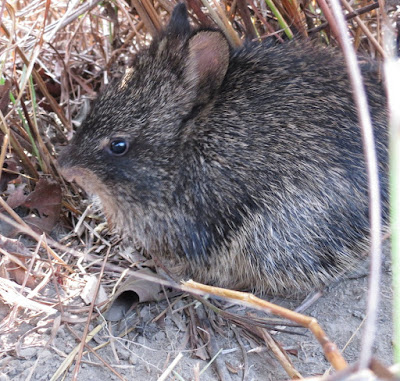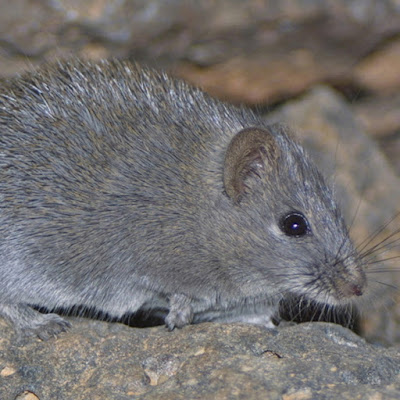[Most Recent Entries] [Calendar View]
Monday, March 19th, 2018
| Time | Event | ||||
| 1:45a | [Mammalogy • 2017] Rediscovery of the Hispid Hare (Caprolagus hispidus) in Chitwan National Park, Nepal After Three Decades
Summary: The critical endangered hispid hare (Caprolagus hispidus) was first recorded as present in Chitwan, Bardiya and Shuklaphanta National Parks of Nepal in 1984. Since then, the species was recorded only in Bardiya and Suklaphanta National Parks. For more than three decades, it had not been observed in Chitwan National Park (CNP), where it was consequently considered extinct. In January 2016, a new recording for the hispid hare took place in CNP, placing that rare mammal again within CNP mammal assemblages. We reported the first photographic confirmation of the presence (30 Jan 2016) of the species in the CNP after 1984. The presence of hispid hare is confined to isolate patched of grassland of the national park. The population of the hispid hare is rapidly declining due to anthropogenic pressure and grassland fire from its distributed range (only found in Nepal, India, and Bhutan). Therefore, further study about their presence-absence, population status need to do throughout the grassland of the low land of Nepal including the newly rediscovering park. Keywords: Hipsid hare, Chitwan National Park, new records, small mammals Bed Bahadur Khadka, Bhupendra Prasad Yadav, Nurendra Aryal and Achyut Aryal. 2017. Rediscovery of the Hispid Hare (Caprolagus hispidus) in Chitwan National Park, Nepal After Three Decades. Conservation Science. 5(1); 10-12. DOI: 10.3126/cs.v5i1.18560 Small mammal thought to be extinct rediscovered in Nepal's national park phy.so/440410736 via @physorg_com | ||||
| 2:04a | [Mammalogy • 2018] Systematics, Distribution and Ecological Analysis of Rodents in Jordan
Abstract Distributional and ecological data were given to all rodents of Jordan. The rodent fauna of Jordan consists of 28 species with 20 genera in eight families (Cricetidae, Dipodidae, Gliridae, Hystricidae, Muridae, Myocastoridae, Sciuridae,and Spalacidae), including four introduced species.Keys for families and species were provided, along with diagnosis for each species and cranial illustrations for most species. Habitat preference and zoogeographic affinities of rodents in Jordan were analyzed, as well as their status and conservation.Threat categories and causes of threats on the rodents of Jordan were also analyzed. The distribution of rodents in Jordan represents a reflection of their global distribution ranges and habitat preferences. Species associated with the temperate forest of northern Jordan includes Sciurus anomalus and two wood mice, Apodemus mystacinus and A. flavicollis, while non-forested areas are represented by Nannospalax ehrenbergi and Microtus guentheri. Strict sand dwellers include Gerbillus cheesmani and G. gerbillus. Petrophiles associated with sandstone or black lava deserts are exemplified by Acomys russatus, A. r. lewsi, H. indica and S. calurus. Others including: Jaculus jaculus, G. nanus, G. henleyi, Meriones crassus, and M. libycus are all desert-adapted species with wider ranges of distribution where scarce vegetation, wadibeds, and marabs with clay, loess, or gravel surfaces provide foraging grounds and shelter. A single species, Gerbillus dasyurus, exhibits a wide range of distribution over diverse habitat types. The rodent fauna of Jordan consists of assemblages of different zoogeographical affinities. Nine, three, and seven were restricted or had most of its range within the Mediterranean, Irano-Turanian, and Saharo Arabian, respectively. Sciurus anomalus, Apodemus sp., Nannospalax ehrenbergi, and Microtus guentheri reached their most southern range of distribution in the Mediterranean regions of Jordan. The distribution of Gerbillus cheesmani extends from Asian deserts in India westwards into the Arabian Peninsula crossing Jordan as its most western range of distribution. Typical rodents of Saharo-Arabian affinities are represented by desert jerboas, gerbils, and jirds. North African species such as G. andersoni, G. gerbillus reached their most eastern distribution in southern Jordan. Both G. henleyi and G. nanus are widely-distributed species across North Africa reaching as far as India to the east, representing most northern outpost for these two species. Sekeetamys calurus is a nearly endemic to the Eastern Mediterranean region within southern Jordan and Sinai. Relicts are represented by Eliomys melanurus and Acomys russatus lewisi. Several threats affecting the rodent biodiversity in Jordan were identified including habitat loss and degradation, human disturbance and related activity, legislative and public awareness. The global conservation status of the rodents of Jordan according to the IUCN Red List include 22 species as least concern, one as near threatened (Allactaga euphratica), and one as data deficient (Nannospalax ehrenbergi). According to the regional assessment, one species is critically endangered, three species are considered endangered, one vulnerable. Keywords: Mammalia, biodiversity, habitat preference, Jordan, rodents, zoogeography
Zuhair S. Amr, Mohammad A. Abu Baker, Mazin Qumsiyeh and Ehab Eid. 2018. Systematics, Distribution and Ecological Analysis of Rodents in Jordan. Zootaxa. 4397(1); 1-94. DOI: 10.11646/zootaxa.4397.1.1 |
| << Previous Day |
2018/03/19 [Calendar] |
Next Day >> |



